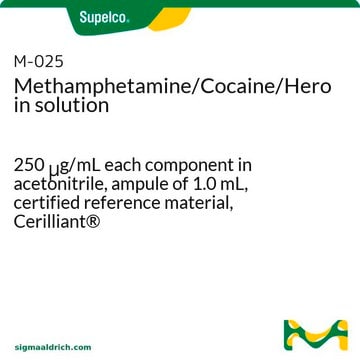This product is sold as a white, photosensitive solid. The data sheet indicates solubility is 2.5 g/mL in water or 300 mg/mL in ethanol. No information is available regarding solution stability after solubilizing the cocaine. A certified reference standard is available as product C1528, with a concentration of 1 mg/mL in methanol. The recommended storage temperature for this product is 2-8 °C. A random Certificate of Analysis shows the product has a 3-year expiration date from the date of quality release.
C5776
Cocaine hydrochloride
Synonyme(s) :
Ecgonine methyl ester benzoate hydrochloride
About This Item
Produits recommandés
Forme
powder
Niveau de qualité
Contrôle du médicament
USDEA Schedule II; Home Office Schedule 2; stupéfiant (France); kontrollierte Droge in Deutschland; regulated under CDSA - not available from Sigma-Aldrich Canada; estupefaciente (Spain); Decreto Lei 15/93: Tabela IB (Portugal)
Application(s)
forensics and toxicology
Chaîne SMILES
Cl.COC(=O)[C@H]1[C@H](C[C@@H]2CC[C@H]1N2C)OC(=O)c3ccccc3
InChI
1S/C17H21NO4.ClH/c1-18-12-8-9-13(18)15(17(20)21-2)14(10-12)22-16(19)11-6-4-3-5-7-11;/h3-7,12-15H,8-10H2,1-2H3;1H/t12-,13+,14-,15+;/m0./s1
Clé InChI
PIQVDUKEQYOJNR-VZXSFKIWSA-N
Vous recherchez des produits similaires ? Visite Guide de comparaison des produits
Application
- in saline control to study the effects of cocaine self-administration in mouse brain[1]
- as adopamine (DA), noradrenaline (NA), and serotonin (5-HT) reuptake inhibitor to evoke neurotransmitter release in artificial fish cerebrospinal fluid (aCSF)[2]
- to examine conditioning to intravenous cocaine hydrochloride[3]
Actions biochimiques/physiologiques
Caractéristiques et avantages
Mention d'avertissement
Danger
Mentions de danger
Conseils de prudence
Classification des risques
Acute Tox. 2 Inhalation - Acute Tox. 2 Oral - Repr. 2 - STOT SE 3
Organes cibles
Central nervous system
Code de la classe de stockage
6.1A - Combustible acute toxic Cat. 1 and 2 / very toxic hazardous materials
Classe de danger pour l'eau (WGK)
WGK 3
Point d'éclair (°F)
Not applicable
Point d'éclair (°C)
Not applicable
Équipement de protection individuelle
Eyeshields, Faceshields, Gloves, type P3 (EN 143) respirator cartridges
Faites votre choix parmi les versions les plus récentes :
Certificats d'analyse (COA)
Vous ne trouvez pas la bonne version ?
Si vous avez besoin d'une version particulière, vous pouvez rechercher un certificat spécifique par le numéro de lot.
Déjà en possession de ce produit ?
Retrouvez la documentation relative aux produits que vous avez récemment achetés dans la Bibliothèque de documents.
-
I wonder that if I dissolve the cocaine in saline, is it stable for long term? Should I storage it in -20 or 4? For how long?
1 answer-
Helpful?
-
Active Filters
Notre équipe de scientifiques dispose d'une expérience dans tous les secteurs de la recherche, notamment en sciences de la vie, science des matériaux, synthèse chimique, chromatographie, analyse et dans de nombreux autres domaines..
Contacter notre Service technique







